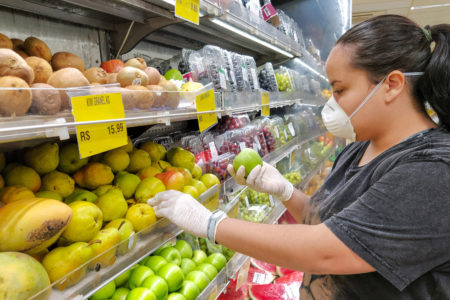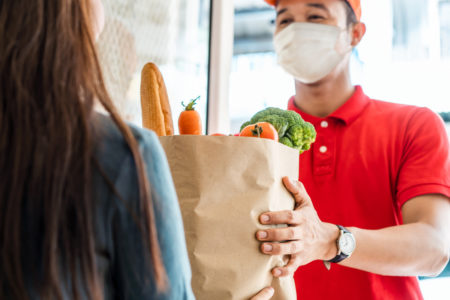
Share On Social!
Millions of Latinos and other Americans of color suffer from a lack of reliable access to a sufficient quantity of affordable, nutritious food.
For years, experts and advocates have described this problem as “food insecurity.”
However, as this conversation takes the forefront after a year of food-insecurity problems highlighted by the coronavirus pandemic, nutrition experts are now saying it is time to address food security in a new light: Through “nutrition security.”
“You’ve probably heard the phrase ‘food security’ to describe consistent access to food,” Cara Rosenbloom, a registered dietitian and the president of Words to Eat By, wrote in a recent Washington Post perspective.
“But many health professionals and policymakers think it’s an inadequate term. Instead, they say, we should be focused on ‘nutrition security.’ That term emphasizes access, availability and affordability of foods that promote well-being and prevent or treat disease, not just foods that provide calories.”
What is the Difference Between Nutrition Security and Food Security?
Historically, food insecurity has more to do with access than quality.
In the 1960s, a national focus on hunger was essential to address major problems of undernutrition after World War II.
The 1990s shifted away from hunger toward “food insecurity” to better capture and address the challenges of food access and affordability.
In the 2020s, access to food, generally, has decreased.
The issue now is more nutrition security and the quality of food at-risk people can access.
Nutrition security means “having consistent access to and availability and affordability of foods and beverages that promote well-being, while preventing — and, if needed, treating — disease,” according to research by Sheila Fleischhacker, an adjunct professor at Georgetown Law School in Washington.
“It’s the right time for this evolution,” Fleischhacker said.
“By prioritizing nutrition security, we bring together historically siloed areas ─ hunger and nutrition ─ which must be tackled together to effectively address our modern challenges of diet-related diseases and disparities in clinical care, government food and food assistance policies, public health investments, and national research.”
This change would require governmental programs helping at-risk families, such as SNAP, to refocus their efforts on providing healthy, nutritious foods to those people — not just something to eat.
Yet convenience stores and food marts, which are some of the only places those living in food deserts or food swamps can buy food, sell unhealthy products. 
This is the case in many Latino neighborhoods, where there is both a lack of grocery stores and an abundance of unhealthy food options, according to a Salud America! research review.
“While national food security programs are in place to help Americans access safe, nutritious and enjoyable foods, there’s a gap,” Rosenbloom writes. “The ‘nutritious’ part often gets left behind, since programs may focus on providing an appropriate amount food or calories rather than ensuring the food is nutrient-dense.”
For example, a school breakfast program could offer nourishing, fiber-filled whole grain bread, cheese and fruit as a mini meal, but many offer juice and a muffin instead.
Both meals may contain the same number of calories, but the latter option is loaded with sugar.
“The ‘nutritious’ part often gets left behind, since programs may focus on providing an appropriate amount food or calories rather than ensuring the food is nutrient-dense,” Rosenbloom writes.
Latinos, Food Insecurity, and Nutrition Insecurity
Food insecurity is prevalent in the United States, especially in Latino and Black communities.
Latino and Black households are more likely to suffer food insecurity (16.2% and 21.2%, respectively) than the national average (11.1%), according to USDA data.
In schools, school meals are rising as a solution to both food insecurity and nutrition insecurity, especially for students of color.
But for Latino students, many attend schools with high levels of access to unhealthy foods and sugary drinks in school stores, snack lines, and vending machines. Latino students ate or drank 47 more “low-nutrient” calories per day than their peers, according to a Salud America! research review.
Now COVID-19 is worsening food access. 
Before the pandemic, “14.3 million American households were food insecure with limited or uncertain access to enough food,” according to Feed America.
While it might take years to understand the impacts fully COVID-19 had on food and nutrition security, the initial findings aren’t looking good, according to Feeding America’s recent “The Impact of the Coronavirus on Food Insecurity” report.
“The Coronavirus (COVID-19) pandemic is impacting vulnerable households in various ways. Many food-insecure individuals have characteristics that put them at a higher risk for severe illness associated with COVID-19,” the report states. “Workers who have service occupations or work in the leisure and hospitality industry are more likely to be food insecure and are at risk of further hardship as many businesses have been forced to close and lay off staff.”
Texas is one of the places struggling with disparities in food insecurity and nutrition security.
“Rates of food insecurity in November 2020 were still high for Texans across the board, but they were at least twice as high for Black (29%) and Hispanic (20%) adults as what white adults reported (12%) for households with children,” according to a report.
What You Can Do to Promote Nutrition Security
Policy leaders can start by making some systemic changes.
The University of Connecticut’s Rudd Center for Food Policy & Obesity offers suggestions for actions that federal, state and local governments can take, including: Creating nutrition standards for kids’ meals and eliminating unhealthy food and beverage marketing to children as a tax-deductible expense.
Moreover, their recommendations include how public health advocates and practitioners can push for changes to these marketing practices.
“Develop campaigns to increase public awareness of the vast amounts of primarily unhealthy fast-food advertising, especially advertising that disproportionately targets children, teens, and communities of color,” the Rudd Center report states. “Support youth-led countermarketing campaigns to expose marketing practices by the top fast-food advertisers.”
Some leaders are stepping up, too. 
Philadelphia began healthy food pharmacies. Atlanta is creating food forests, and New York’s plans to help grocery stores donate excess food to charity.
You can also make a difference in your community’s nutrition.
Download a Salud America! Health Equity Report Card!
The report card will show you how many local children live in poverty and food deserts, how many have low food access, and how many get SNAP food benefits. Then you can compare it to your state and to the country.
Email your Health Equity Report Card to community leaders, share it on social media, and use it to make the case to address food insecurity where help is needed most!
GET YOUR HEALTH EQUITY REPORT CARD!
Explore More:
Healthy FoodBy The Numbers
1
Supermarket
for every Latino neighborhood, compared to 3 for every non-Latino neighborhood



